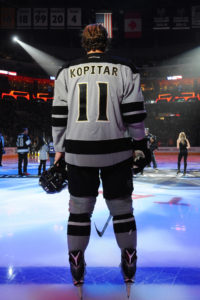
Juan Ocampo/NHLI
This season: 76 games, 12 goals, 40 assists, 52 points, 28 penalty minutes, -10 rating, -1.1% CF%Rel, 20:46 time on ice
The good: In a confusing quagmire of a season that should endure as the most challenging of his professional career, Anze Kopitar was unable to productively emerge from a perfect storm of unfortunate factors and generated only intermittent momentum in a year in which other heavily tread international centers such as Jonathan Toews and Patrice Bergeron also took a while to get going before marginally outscoring the Kings center. That such a slog took place in the first year of his eight-year, $80-million contract and in the immediate aftermath of the transfer of the captaincy represents less than ideal optics and became a burden for a player who takes immense pride in his game and in ensuring that it’s played at an elite level. More about What Went Wrong and the likeliness that this was a one-off irregularity at this stage of his career will come. First, the positives begin with a broader view. The Kings allowed 2.45 goals per game, the sixth best rate in the league, even though their defense rotated three players with limited NHL experience in the second half and the goalie who opened the season as the third string option started 51 games. Despite his offensive shortcomings and the team’s challenging set of criteria, the reigning Selke trophy winner remained bound to his defensive and checking excellence, ranking sixth among centers in average ice time per game and serving as a significant factor in Los Angeles’ ability to keep the puck out of its own net. This checking acumen is derived from his excellent attention to detail and ability to adhere to a tightly structured system, and he used it to face the toughest competition in his career (as represented by a career-high 55.6% Opp CF60) and, for the fourth consecutive season, started the lowest percentage of shifts in the offensive zone out of any L.A. forward. A player with traditionally strong penalty plus-minus, Kopitar drew 27 minor penalties, the most he had drawn in any season since 2010-11, and finished with a plus-14 penalty differential. He dealt with a significant injury in the first half of the season that limited his effectiveness in the immediate aftermath but remained durable; by playing in 76 of 82 games, his availability rate dropped to 96.8% of all possible regular season games. He won at least 52.5% of his faceoffs for the sixth consecutive year. “He’s a captain, he plays a lot of minutes, he plays a lot of situations, and he’d like to score more,” Darryl Sutter said before he was asked whether there was anything that differentiated Kopitar’s season from any previous season. “No, I’d say he’s the hardest working player on our team,” he answered.
The bad: There was certainly an array of other factors to affect his season, but perhaps the largest issues that put a ceiling on Kopitar’s production were his inability to consistently generate high-quality opportunities by driving down the center of the ice, his decreased shot rate, and the lack of first line caliber options to regularly play alongside him. As a result, he suffered an 18-point drop in five-on-five scoring, he scored a career-low seven five-on-five goals, his 5.16 Sh/60 was the lowest shot rate of his career and his 7.2% 5×5 shooting percentage was the lowest of his career as he dropped from 2.18 5×5 Pts/60 to 1.38. “If you look at him trying to get into the middle of the ice and take more quality shots. If he does that, he’s going to score,” Sutter said in early February. “He’s hit a lot of posts, things like that. He could easily be in double-figures in goals, and then nobody would be even talking about Kopi. They’d still be saying he was one of the best checking centermen in the league and all those things.” There were several other observations that Kopitar need to drive to the net and shoot more made around that time of the year. Though there are aspects of his own game that he’ll look to refine for 2017-18, there was something he had no control over that ultimately had a major effect on his 2016-17 season: Milan Lucic was no longer around. The Kopitar-Lucic duo was dy-no-mite the year prior, especially in the second half of the season as they raised the team’s GF60 while alongside each other to a remarkable 3.76. With Lucic gone, and with Marian Gaborik – who had been expected to serve as part of a Gaborik-Kopitar-Brown trio to open the season – out for the early part of the season with a broken foot, there wasn’t much in the way of proven, reliable offense atop the Kings lineup. After Gaborik (438:52) and Brown (257:42), Kopitar’s next most frequent linemates were Trevor Lewis (282:06) and Dwight King (242:17), so during those frequent mid-season junctures when coaches make adjustments to their lineups, there weren’t exactly Grade-A, preferred top-line options at the ready. Still, players like Kopitar should be expected to make those around them better, and in December Sutter dismissed the theory that those chosen to play alongside Kopitar had an effect on his overall output. “He should make players around him better. That’s what elite players do. Look at #19 on Chicago. Play a lot of kids. He plays with everybody, right? Kopi does that,” Sutter said. “It’s not just about points for Kopi. I mean, it’s got nothing with who he plays with.” Still, much of what we all heard from inside and outside of the organization was that the team was interested in finding a low-cost forward to play alongside Kopitar at the trading deadline. That ultimately turned out to be Jarome Iginla, who totaled six power play points and nine points total in 19 games with the Kings but was scored on to a wider degree when skating alongside Kopitar during five-on-five play.
During the peak stages of their championship pursuit, the Kings were a team overstuffed with emotional, character figures whose veteran leadership qualifications seemed to be greater than the sum of their parts. A pillar of that championship-tested leadership group and the most highly skilled player at the most important position, Kopitar wasn’t expected to juggle any superfluous luggage following the transfer of the captaincy from Dustin Brown. The most difficult aspect of a player’s performance to evaluate is the nebulous concept of “leadership,” which doesn’t have any concrete, universal meaning and is as likely to be represented in closed-door episodes as it is through viewable, on-ice events. Kopitar is a star, a lead-by-example type of player with outstanding work and practice habits and a high level of skill. He’s a coach’s son and has the capacity to draw from a number of influences in the way he conducts himself as captain. It just never seemed to be the most fluid transfer of the “C” as Kopitar took time to balance out the additional requirements. “The captaincy is new, yes, and I’d be lying if I said that I had everything down and know what I’m doing,” he said in December. “You know, it’s a learning process and the first year is obviously harder than any else and I’m trying to figure it out, trying to see the balance between leading the team, speaking up, you know, all of that stuff. So I’m learning, but I feel like I’m on the right path and I’m obviously going to embrace the challenge, and I’m looking forward to it.” In late March, he told Helene Elliott of the LA Times that he was “still learning.” “I don’t know if you can learn that overnight,” he said.
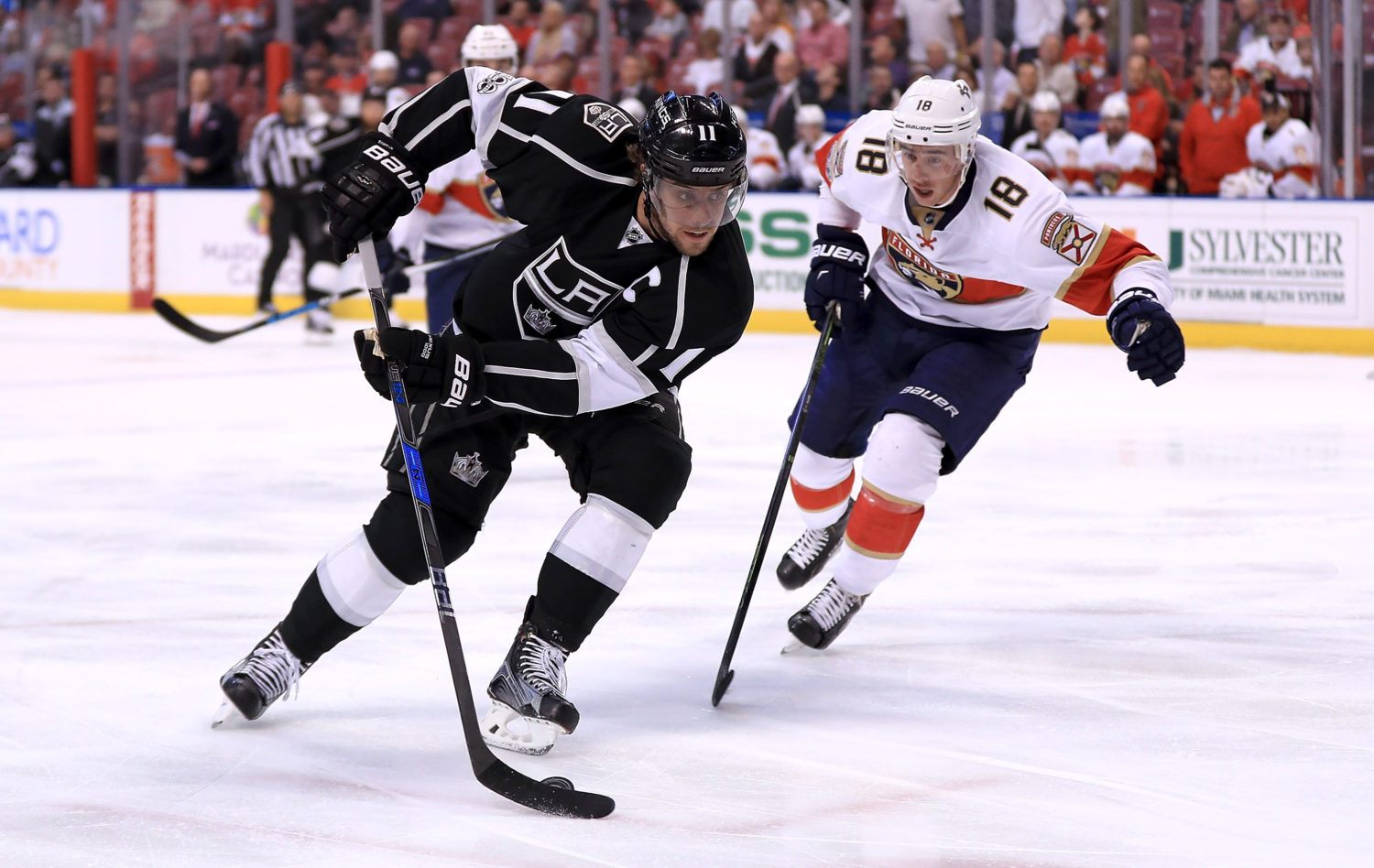
Mike Ehrmann/Getty Images
Going forward: This is where it gets so interesting. Kopitar should be an easy and reliable bet for a bounce-back season, and likely several bounce-back seasons to come. The questions aren’t really tied to the immediate future, but rather to the prospects of what the Kings will receive from their investments some years down the road. What will a 36-year-old Kopitar provide for a $10-million cap hit in 2023-24? What would he look like at 34 alongside a 37-year-old Brown ($5.875M), a 36-year-old Carter ($5.272M) and a 35-year-old Quick ($5.8M) in 2021-22? These questions are, of course, impossible to answer right now, and rather than rabblerousing with hypotheticals, here’s what we know about this coming season under John Stevens: the Kings will be hellbent on increasing their offense, and the degree to which such an endeavor will succeed will lean significantly but not entirely on how big of a rebound both Kopitar and Tyler Toffoli experience. “I think part of our identity as a hockey team has to be that the LA Kings are a team that goes hard to the net, and quite honestly, if we lead the league next year in coaches challenges for goalie interference, I’d be really happy about that,” Stevens said at his introductory press conference, and as a 6-foot-3, 224-pound puck protection behemoth, Kopitar will be relied upon to pull the weight there. The team has also acknowledged that it will be looking to transfer its possession advantage into actual cold, hard offense, and will be searching for the types of players capable of successfully distributing the puck into high-danger areas in the attacking zone, and again, that should align with the skill set of a player who ranks eighth in the NHL with 481 assists since 2006-07. There was so much terrific stuff on how the Kings plan on proceeding here shared by Stevens and Rob Blake at the press conference to introduce Los Angeles’ new coach. “I think the middle of the ice has always been important to this team,” Stevens said. “When you look at the guys we’ve had down the middle of the ice – when we won with Kopitar and Carter and Richards and Stoll and Colin Fraser before that – I just think that center ice is a really important part of the game. It doesn’t always have to come from the defense if you relay plays off the wall, but everyone talks about analytics. Analytics tells you we don’t get enough scoring opportunities from the middle of the ice and that’s clearly an area where, whether it’s quickly off a transition forecheck and you’re going to try to get to those areas, you’re going to have people there more, and spend more time around the net. But it’s clearly an area we’re going to focus on.”
It led into a discussion with Blake about Kopitar’s conditioning, which had seemingly been a strength of his game and allowed for such durability throughout his career, but apparently needed to evolve alongside others in similarly leaned-upon roles. “I’ve had a conversation with Kopi the last couple weeks and a lot of it revolves around his off-season training and to look at the top players – the Toews’, the Crosby’s – and see what they’re doing off ice because there has to be an element, when you get to a certain age, to be able to play at a high level, the off-season becomes such an important factor,” Blake said. “So I know our strength guys have met with Kopi and he’s got a real good attitude and understanding of what he needs to accomplish to get back to that high level.” Interestingly, Sutter had noted in December that Kopitar had been “really good early in games” and that “his ability to sustain a high level, which we expect out of him for the course of the game is something he’s got to work on.” Clearly, it should be beneficial that he won’t have to begin his 2017-18 campaign with early September Olympic qualification, and then six games against top players at the World Cup, before reporting to Los Angeles.
“It’s a different style of game than it was eight years ago, and the quickness aspect has to be in there,” Blake continued. “And listen, there’s a lot of things – the team wasn’t having success, I don’t think he had the success, he’s a new captain, there’s a ton of stuff that goes into it. Kopi will be fine. He’s a smart kid. He understands the game and he knows where he is and like I wanted to make sure he understands, he’s in that top group with all these other elite players, and there’s no problem looking at what they do. I’ve done it myself and Luc has done that certain times in his career. Look at the best players, see what they’re doing. You have to adapt as you go, but age and stuff come into effect.”
Kopitar evaluations: 2016 | 2015 | 2014 | 2013 | 2012 | 2011 | 2010 | 2009 | 2008
Player evaluations: ANDREOFF | BROWN | CARTER | CLIFFORD | DOUGHTY | DOWD | FORBORT | GABORIK | GRAVEL | KOPITAR | LEWIS | MARTINEZ | MCNABB | MUZZIN | NOLAN | PEARSON | SHORE | TOFFOLI | BISHOP/BUDAJ/CAMPBELL/QUICK/ZATKOFF | THE OTHERS
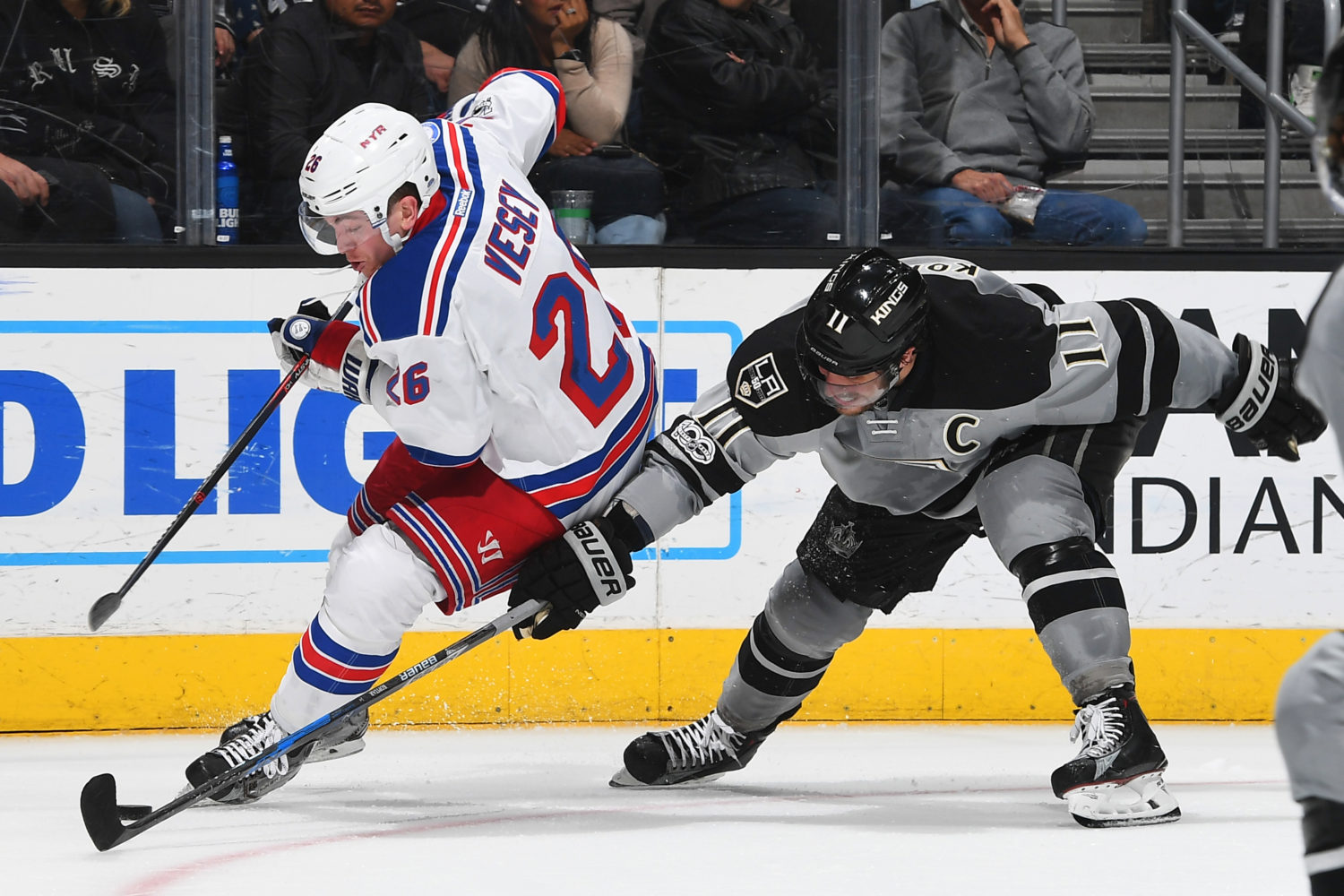
Aaron Poole/NHL
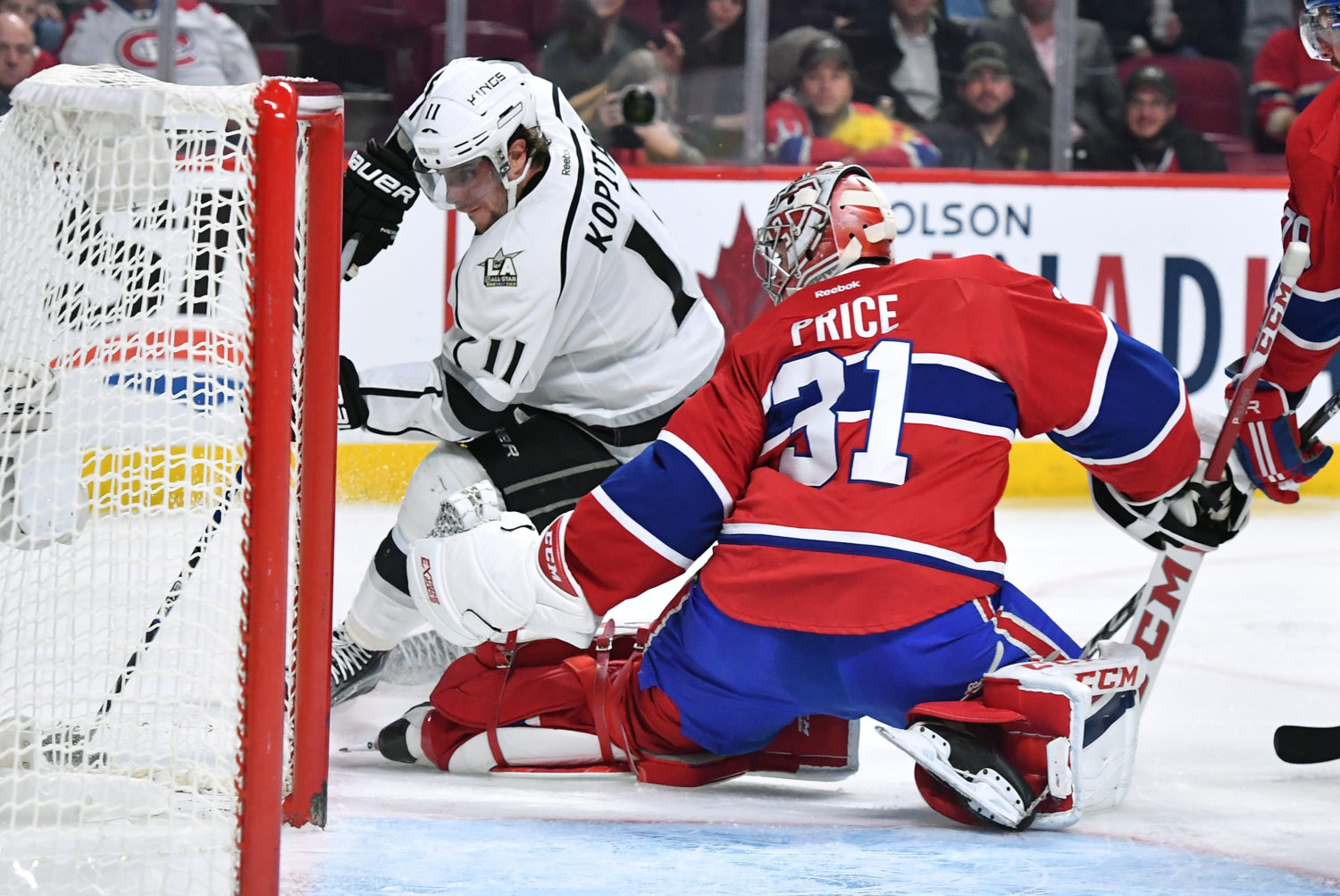
Francois Lacasse/NHLI

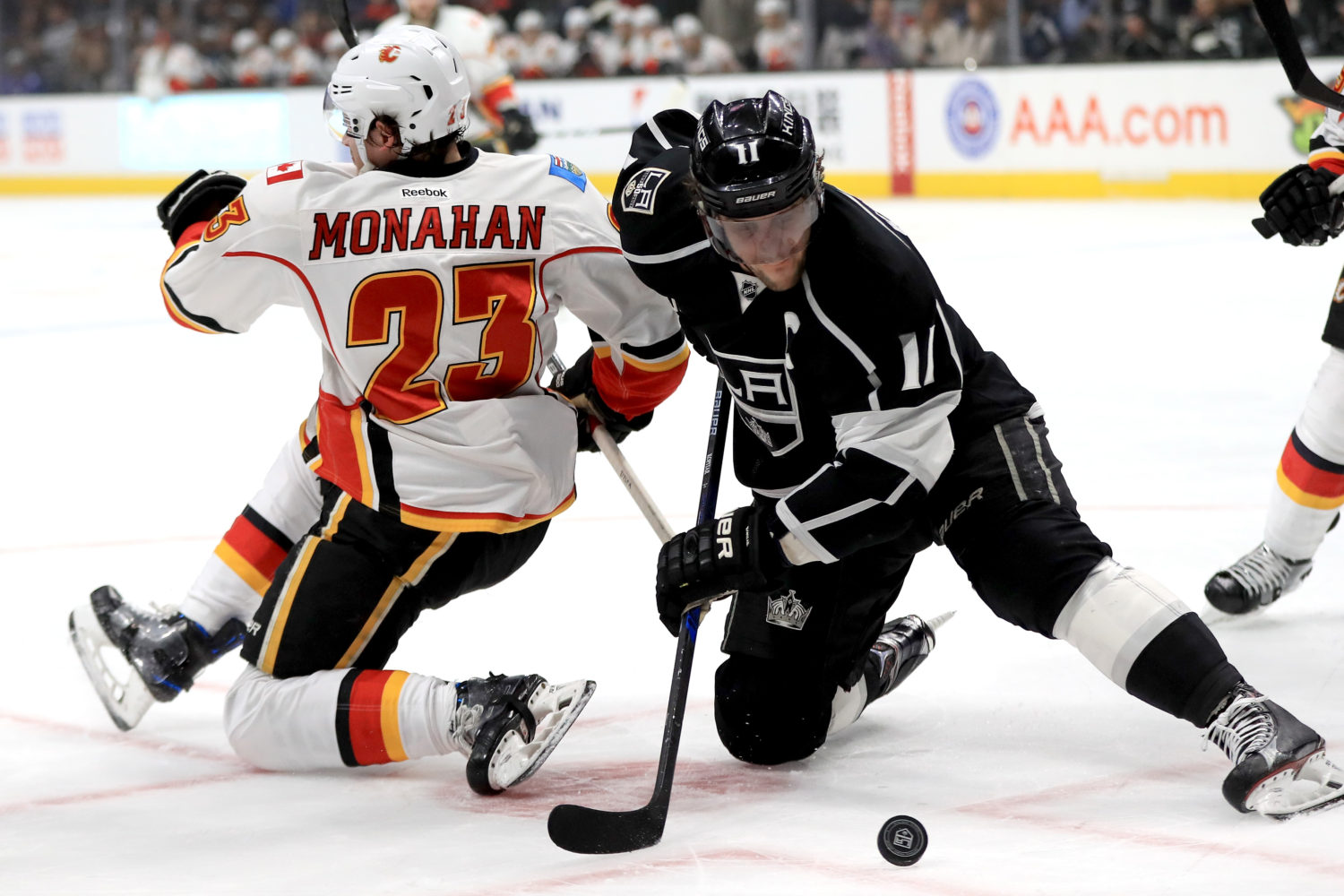
Rules for Blog Commenting
Repeated violations of the blog rules will result in site bans, commensurate with the nature and number of offenses.
Please flag any comments that violate the site rules for moderation. For immediate problems regarding problematic posts, please email zdooley@lakings.com.